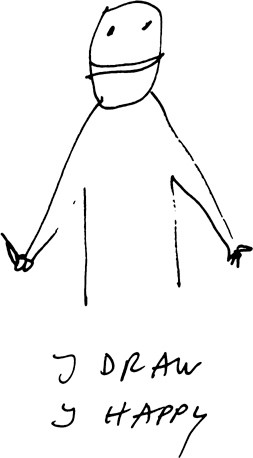
Dan Perjovschi, I Draw I Happy, 2004 © Dan Perjovschi
The 1st at Moderna: Dan Perjovschi
May First
1.5 2006 – 6.8 2006
Stockholm
This exhibition established Perjovschi’s international reputation and since then, armed with his notebook and pens, he travels the world exhibiting in galleries, museums and at biennials. He has become a globetrotter but remains faithful to Bucharest, even though he seems to have a love/hate relationship to his native country, indicated by a self-portrait in which he drags a map of Romania attached to his ankle by a chain.
Dan Perjovschi works much like an anthropologist. He spends time in and gets to know the places where he exhibits. He talks to people, observes, listens to gossip and the local news. He records his discoveries and experiences as drawings in a notebook, some 30% of which find their way onto walls or other surfaces. When he creates his drawings in the museum during opening hours, his work takes on a performative aspect, sometimes including the public, which may even influence the end result.
His minimalist and rapidly executed drawings respond to the social and political context in which they are made, and incorporate personal, regional, and global issues in a direct and reduced manner. Consisting of only a few lines, these economic, rudimentary drawings nevertheless create convincing and meaningful world views. The concise strokes easily transform into something else – the peace symbol is just one line away from the Mercedes-Benz logo, a thought bubble turns into a rain cloud. Writing is an intrinsic part of the drawings. Witty wordplay, incisive and caustic comments are added, words are sometimes crossed out making visible the artist’s thought process.
Perjovschi’s talent for condensing complex ideas into direct visual images may be a skill that he has honed as an editor and political cartoonist since 1991 at the oppositional weekly magazine 22. The publication has taken its name from that fateful day in December 1989 when the Romanian dictator Ceausescu was ousted from power.
These ephemeral interventions in the white cube or in the urban environment provide reflections on current situations, and just as today’s news is tomorrow’s chip paper, at the end of the exhibition period the wall will be painted white again and something else will be news.
Dan Perjovschi’s art is analysis, polemics, criticism and empathy all rolled into one. Whether he is commenting on or raising questions about concepts of identity, East/West issues, EU enlargement, consumerism or the mechanisms of the artworld (“Shows on east art had always western curator”), it is always with irony and humour. Take for example his drawing of a pint of beer and a man’s head with the caption, “Beers are like artists. Everyone is the best in the world”. Or the self-portrait he made for his first show in London, which reveals the artist worrying, “I don’t think I’m cool enough”.
No stranger to Stockholm, Dan Perjovschi spent three months here as an artist-in-residence at IASPIS in 1999 and participated in the exhibition After the Wall: Art and Culture in Post Communist Europe at Moderna Museet the same year. He returned to Stockholm in March this year to select the location for his May First project.
May First comprises two parts, one visible and public and one more hidden and private. The first one is what we can now term a “classic Dan Perjovschi” – a drawing on the cloakroom wall. The second can be found around the corner from the cloakroom at the lockers where visitors can deposit their belongings. In each of the plastic pockets inside the lockers – where one usually finds information on the museum’s exhibitions – he has placed a drawing. Each locker holds a surprise, prompting questions such as: Is there a drawing in the adjacent locker? Is it the same as mine? Is there a drawing in all the lockers? Is it a series? To find out one would have to open all 144 lockers.
“I rather draw than write. My projects/drawings are improvised, half performance, and developed according to the space and mood. World mood. Accidents may happen. Mistakes may occur. I understand the world if I draw it. As simply and directly as possible. Intellectual graffiti, political cartoons, kids drawings. A language for the 21st century.”
Dan Perjovschi, January 2006
Karen Diamond
Dan Perjoschi
Born in 1961 in Sibiu, Romania. Lives and works in Bucharest.
Education
1980–1984
Fine Arts, George Enescu Art University, Iasi, Romania
Latest three solo exhibitions
2006
Dan Perjovschi, Van Abbemuseum, Eindhoven
Not me but you, not now but later, Kunstraum Innsbruck, Innsbruck
Back to Back, Lombard Freid Projects, New York (with Nedko Solakov)
Latest three group exhibitions
2006
Normalisation, Rooseum Center for Contemporary Art, Malmö
Borremans, Bryce, Perjovschi, Wurtembergischer Kunstverein, Stuttgart
2005
Istanbul, 9th International Istanbul Biennial, Istanbul
The 1st at Moderna is an exhibition programme for contemporary art. The opening is always on the first day of the month, and the exhibitions are in different venues in or outside the museum.
